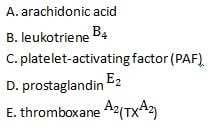Exam Details
Exam Code
:USMLE-STEP-1Exam Name
:United States Medical Licensing Step 1Certification
:USMLE CertificationsVendor
:USMLETotal Questions
:847 Q&AsLast Updated
:Apr 17, 2025
USMLE USMLE Certifications USMLE-STEP-1 Questions & Answers
-
Question 491:
The process of RNA editing leads to sequence changes that are not reflective of the genetic information contained within the gene for an edited RNA. RNA editing occurs through the action of specific nucleotide deaminases that change either adenine to inosine or cytidine to uridine. These nucleotide changes can affect the coding or splicing capacity of the RNA. Which of the following proteins is an important example of the result of RNA editing?
A. apo B48
B. calcitonin gene-related peptide
C. ferritin
D. glutamate dehydrogenase
E. tissue factor (factor III)
-
Question 492:
Carnitine, a zwitterionic compound derived from lysine, is involved in fatty acid metabolism and is required at which two points in the transport of fatty acids from the cytoplasm to the mitochondria (see below figure)?

A. A and E
B. A and C
C. B and C
D. B and D
E. E and D
-
Question 493:
The term "genomic imprinting" refers to the phenomenon of gene expression dependence on the mode of inheritence. A typical example of this phenomenon is the control of the expression of the growth factor IGF- II. Genomic imprinting, termed "epigenesis," is defined by which of the following?
A. Gene expression results from regulated levels of DNA methylation.
B. Gene expression that is restricted to a specific cell lineage.
C. Gene regulation is exerted by sex-type specifc factors.
D. Genotype differences are not reflected by phenotype differences.
E. Phenotype differences are independent of genotype variation.
-
Question 494:
The bacterial lac operon is controlled by both glucose and lactose levels. Which of the following conditions would result in the greatest level of transcription from the lac operon?
A. both glucose and lactose present
B. glucose present but no lactose
C. lactose present but no glucose
D. no glucose or lactose present
-
Question 495:
An observation that has been made over the past several decades is that certain dominantly inherited disorders exhibit earlier age of onset along with increasing severity in successive generations. This phenomenon is referred to as anticipation. Amost striking example of this genetic trait is characterized by muscle wasting beginning with the face, neck, and hands gradually becoming generalized and by the inability of muscles to relax after contraction. These symptoms and the phenomenon of anticipation are associated with which of the following diseases?
A. becker muscular dystrophy (BMD)
B. DMD
C. Marfan syndrome
D. myotonic dystrophy
E. osteogenesis imperfecta
-
Question 496:
You are studying the effects of a compound on the respiratory activity of isolated mitochondria. Your experiments demonstrate that oxygen consumption is normal when pyruvate and malate are added. Oxygen consumption is also seen to be normal when succinate is added. However, you find that the production of ATP is severely impaired in the presence of pyruvate/malate or succinate when the compound is added to the reaction. These results most closely resemble the effects that would be seen by the addition of which of the following inhibitors of oxidative phosphorylation?
A. antimycin A
B. azide
C. dinitrophenol
D. oligomycin
E. rotenone
-
Question 497:
The inability to rapidly synthesize DNA during the process of erythrocyte maturation leads to abnormally enlarged erythrocytes. This disorder is referred to as macrocytic anemia and is caused by a deficiency in which of the following vitamins?
A. ascorbate
B. biotin
C. folate
D. niacin
E. thiamine
-
Question 498:
A 12-year-old boy has suffered from chronic sinopulmonary disease including persistent infection of the airway with Pseudomonas aeruginosa. He has constant and chronic sputum production as a result of the airway infection. Additionally, he suffers from gastrointestinal (GI) and nutritional abnormalities that include biliary cirrhosis, meconium ileus, and pancreatic insufficency. The symptoms are classical for which of the following disorders?
A. congenital adrenal hyperplasia
B. CF
C. Renal Fanconi syndrome
D. sickle cell anemia
E. Tay-Sachs disease
-
Question 499:
Exhbit:

Please refer to the exhibit. Hypersensitive individuals have IgE to specific antigens (e.g., pollen, bee venom) on the surface of their leukocytes (monocytes, macrophages, basophils, eosinophils). When these individuals are challenged with antigen, the antigen-IgE complexes induce synthesis and release of which of the following physiologically potent lipids?
A. A
B. B
C. C
D. D
E. E
-
Question 500:
Acetyl-CoA enhances the rate of gluconeogenesis by acting as an allosteric activator of which of the following enzymes?
A. ACC
B. PEP-carboxykinase
C. pyruvate carboxylase
D. PDH
E. pyruvate kinase
Tips on How to Prepare for the Exams
Nowadays, the certification exams become more and more important and required by more and more enterprises when applying for a job. But how to prepare for the exam effectively? How to prepare for the exam in a short time with less efforts? How to get a ideal result and how to find the most reliable resources? Here on Vcedump.com, you will find all the answers. Vcedump.com provide not only USMLE exam questions, answers and explanations but also complete assistance on your exam preparation and certification application. If you are confused on your USMLE-STEP-1 exam preparations and USMLE certification application, do not hesitate to visit our Vcedump.com to find your solutions here.